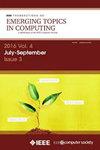用于高速信念传播的软件定义数字格式
IF 5.4
2区 计算机科学
Q1 COMPUTER SCIENCE, INFORMATION SYSTEMS
IEEE Transactions on Emerging Topics in Computing
Pub Date : 2025-01-20
DOI:10.1109/TETC.2025.3528972
引用次数: 0
摘要
本文介绍了用于高速实现信念传播(BP)算法的软件定义浮点(SDF)数字格式的设计和实现。SDF格式是专门为满足计算的数字需求而设计的,是数据的更紧凑的表示形式。它们在不牺牲精度的情况下减少了内存占用和内存带宽需求,因为循环图的BP固有地包含算法错误。通过对计算过程的仔细分析,设计了几种用于和积BP应用的SDF格式。我们的理论分析导致了16位(半精度)和8位(微精度)宽度的设计。此外,我们还提供了所提出的SDF格式的高效软件实现,其核心是转换为硬件支持的单精度算术硬件。我们的解决方案在商用cpu上的转换开销可以忽略不计。对于尺寸从100 × 100到500 × 500的Ising网格,16位和8位SDF格式以及我们的转换模块可以产生与双精度浮点格式相当的精度,但在英特尔至强处理器上平均速度为2.86倍。特别是,增加网格大小会导致更高的加速。例如,所提出的3位指数和13位尾数的半精度格式通过将网格大小从100 × 100增加到500 × 500,在单精度上实现了1.30倍和1.39倍的最小和最大速度,在双精度上实现了2.55倍和3.40倍的最大速度。本文章由计算机程序翻译,如有差异,请以英文原文为准。
Software-Defined Number Formats for High-Speed Belief Propagation
This article presents the design and implementation of Software-Defined Floating-Point (SDF) number formats for high-speed implementation of the Belief Propagation (BP) algorithm. SDF formats are designed specifically to meet the numeric needs of the computation and are more compact representations of the data. They reduce memory footprint and memory bandwidth requirements without sacrificing accuracy, given that BP for loopy graphs inherently involves algorithmic errors. This article designs several SDF formats for sum-product BP applications by careful analysis of the computation. Our theoretical analysis leads to the design of 16-bit (half-precision) and 8-bit (mini-precision) widths. We moreover present highly efficient software implementation of the proposed SDF formats which is centered around conversion to hardware-supported single-precision arithmetic hardware. Our solution demonstrates negligible conversion overhead on commercially available CPUs. For Ising grids with sizes from 100 × 100 to 500 × 500, the 16- and 8-bit SDF formats along with our conversion module produce equivalent accuracy to double-precision floating-point format but with 2.86× speedups on average on an Intel Xeon processor. Particularly, increasing the grid size results in higher speed-up. For example, the proposed half-precision format with 3-bit exponent and 13-bit mantissa achieved the minimum and maximum speedups of 1.30× and 1.39× over single-precision, and 2.55× and 3.40× over double-precision, by increasing grid size from 100 × 100 to 500 × 500.
求助全文
通过发布文献求助,成功后即可免费获取论文全文。
去求助
来源期刊

IEEE Transactions on Emerging Topics in Computing
Computer Science-Computer Science (miscellaneous)
CiteScore
12.10
自引率
5.10%
发文量
113
期刊介绍:
IEEE Transactions on Emerging Topics in Computing publishes papers on emerging aspects of computer science, computing technology, and computing applications not currently covered by other IEEE Computer Society Transactions. Some examples of emerging topics in computing include: IT for Green, Synthetic and organic computing structures and systems, Advanced analytics, Social/occupational computing, Location-based/client computer systems, Morphic computer design, Electronic game systems, & Health-care IT.
 求助内容:
求助内容: 应助结果提醒方式:
应助结果提醒方式:


